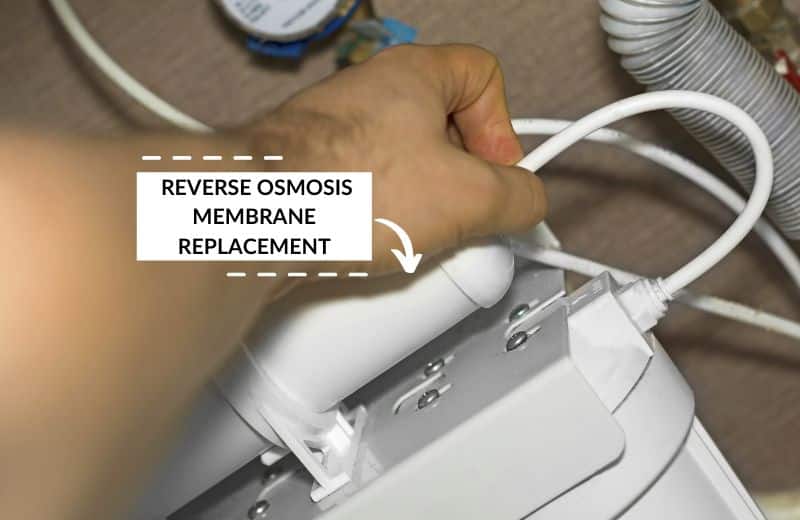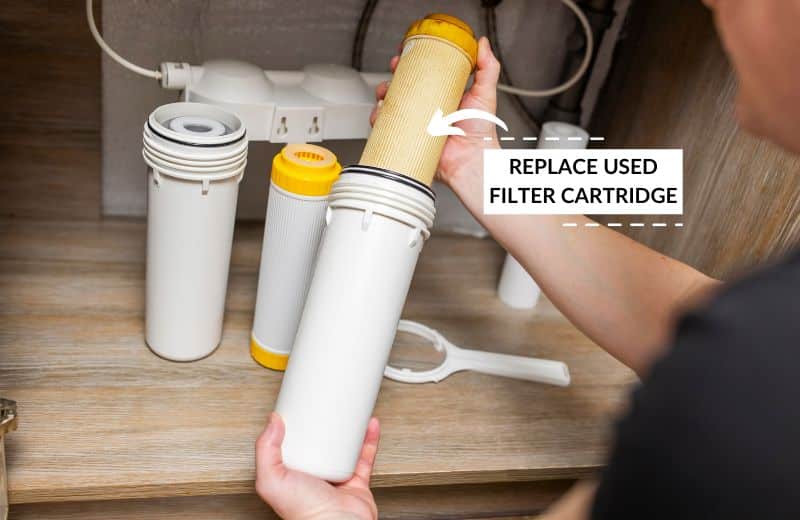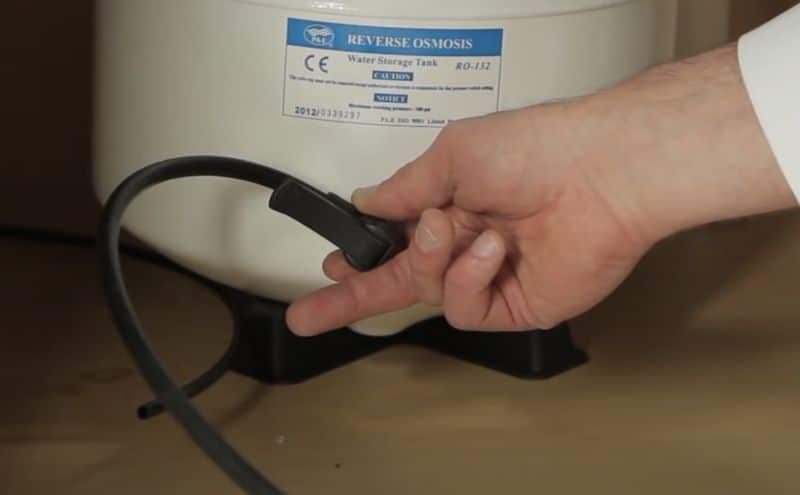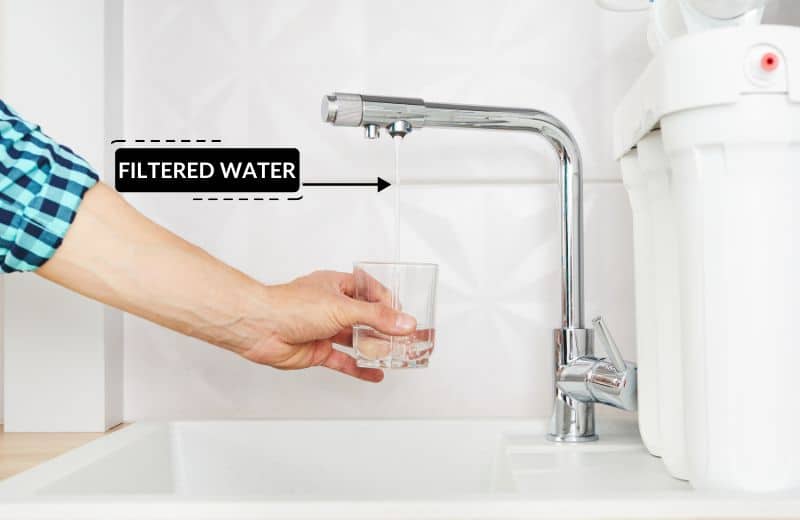Low water pressure and slow flow from your reverse osmosis system is far from ideal. You want quick access to your drinking water, without having to spend precious minutes waiting for your glass to fill.
Luckily, pressure issues don’t usually mean you’ll have to buy a new reverse osmosis system. Here, we’ve outlined the top 6 causes of a slow water flow rate in a reverse osmosis system, and what you can do about them.
📌 Key Takeaways:
- Low incoming water pressure, a clogged RO membrane and clogged filters, and low pressure in the water storage tank are all causes of low pressure in an RO system.
- You can restore normal water pressure in a reverse osmosis system by increasing the tank pressure or replacing a ruptured RO tank bladder, replacing clogged filters, flushing a line kink, or increasing low incoming water pressure.
Table of Contents
📉 6 Causes Of Low Water Pressure In RO System & How To Fix
1) Clogged RO Membrane
One of the most likely causes of low water pressure in an RO system is a clogged RO membrane.
Most RO membranes have a lifespan of around 24 months. A new membrane provides optimal water flow, but the membrane gradually becomes clogged with contaminants over time, reducing the space for water to pass through.
This slows down the rate of water flowing through the system, reducing the output water pressure.
Related: How to Tell if RO Membrane is Bad (6 Obvious Signs)
How To Fix: Replace The Membrane
You can’t clean or flush the membrane to restore it to its former self. The only solution is to replace the membrane entirely.
New RO membranes usually cost $30-$120, depending on the membrane size and whether or not any add-ons are required.

2) Low Incoming Water Pressure
Most reverse osmosis systems need an incoming water supply pressure of at least 40 PSI to operate. An incoming water line pressure of 60 PSI is ideal for optimal performance.
If your incoming water pressure is lower than this, the RO system might not be able to send water with enough force through the RO membrane, causing water to get trapped in the RO chamber and reducing the system’s efficiency. As a result, the water leaving the system will be slower.
How To Fix: Install An Electric Booster Pump
The best way to fix a slow flow rate caused by low feed pressure is to install a pressure booster pump at your water supply line.
This will send water through your pipes at a faster rate and will reduce issues with low or fluctuating water pressure.
Also check that your water supply valve is fully open. If the valve is closed slightly, this will reduce your water’s incoming pressure.
3) Clogged RO Filters
Clogged RO filters pose the same issue as a clogged RO membrane.
A clogged filter is packed with contaminants that prevent water from easily passing through the filter pores, reducing the flow of water out of the RO system.
How To Fix: Replace The Filters
To prevent clogged RO system filters from reducing water flow and pressure, make sure to replace the filters as advised by the manufacturer. In a typical under-sink or countertop system:
- The sediment pre-filter lasts 6 months
- The carbon filter lasts 9-12 months
- The post-filter lasts 12-18 months

4) Low Air Pressure In RO Tank
Low tank pressure in the RO system could also be to blame for reduced water flow in your RO system.
The ideal air pressure in an RO storage tank is 7-8 PSI when the tank is empty. Check your user manual to learn how to get a pressure reading in the tank. If it’s too low, it could be reducing the water flow from the unit, you’ll need to repressurize the tank.
How To Fix: Increase The Pressure
Follow these steps to increase the air pressure inside your RO storage tank.
5) Ruptured Tank Bladder
A ruptured air bladder is a more serious problem that might cause your RO pressure and flow rate to reduce.
If your water pressure remains consistent for about 1 cup, then gradually slows to a trickle, you probably have an air bladder rupture in the pressure tank.
How To Fix: Replace The Bladder
It’s impossible to repair the air bladder effectively, so the only solution to restore pressure in your water supply is to replace the bladder entirely.
It might be easier, more convenient, and more cost-effective to replace the entire storage tank in your RO system.

6) Kink In The Line
Finally, a kink or pinch in the RO water supply lines may reduce water flow through the system, resulting in lower pressure from the RO faucet.
How To Fix: Flush The Kink
You can resolve a kink in the line by flushing the pipe with water from your normal faucet, or replacing the water line altogether.
🤔 Is Low Pressure In RO System Normal?
We wanted to quickly point out a truth about the water pressure from an RO system: it’s always going to be lower than your normal faucet water pressure.
The reverse osmosis process slows down water’s normal flow through the pipes. The numerous filter stages cause resistance, and the speed of water leaving the system is lower as a result.
It’s normal for your water flow to be half the speed from the RO faucet than it was prior to the system installation. But if you have a very slow flow rate, it might be due to one of the above causes.

Continue Reading:
📑 Final Word
Low pressure in a reverse osmosis system is usually an easy fix. In most cases, reduced water flow from your RO system will be caused by issues with the filters or RO membrane, and replacing the filters or membrane will resolve the issue immediately.
More rarely, you’ll need to repair the water storage tank or increase the tank air pressure.
If you’ve tried everything and your RO water flow is still lower than advertised by the manufacturer, reach out to customer service and ask for some help.
